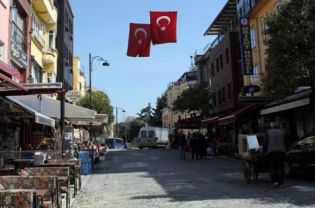Istanbul is the only city in the world that sits on two continents — Europe and Asia. As Turkey’s biggest city, it is every bit the modern metropolis, with constant traffic by bridge and ferry over the Bosphorus Strait that connects East and West. But it is the city’s history that tourists come to experience, and they know just where to find it: Istanbul’s Old City, Sultanahmet.

“Tourists visiting Sultanahmet say they have seen the real Istanbul,” said Dilek, my Turkish guide. Located on Istanbul’s European bank, the historical center is one of the city’s most popular tourist attractions.
Along with Eminonu, Sultanahmet is the oldest and longest-inhabited part of modern Istanbul. It is a former capital of three great world empires: The Roman Empire (AD 330-395), the Byzantine Empire (395-1204 and 1261-1453) and the Ottoman Empire (1453-1922).
The Roman Emperor Constantine the Great established the city as new Rome in 330 and named it after himself, Konstantinopolis, or Constantinople in English. During the Turkish Ottoman Empire it was called Kostantiniyye. In 1930, the Turkish authorities adopted Istanbul, a name that has existed since the 10th century, as the sole name of the city.
Istanbul’s most ancient and historical buildings are concentrated in the Sultanahmet area. In 1985, it was added to the Unesco World Heritage List.
On a recent visit to the Old City, I found it to have a fascinating mix of modern and traditional life, a place where secular and religious life run in parallel.
The Sultanahmet area is named after Sultan Ahmet Khan I, the 14th sultan of the Ottoman Empire. During his reign, he built the Sultanahmet Mosque, between the years 1609 and 1616. It is popularly known as the Blue Mosque, because of the blue tiles that decorate the interior walls, and is considered a masterpiece of mosque architecture in Islamic history.
The mosque faces the Hagia Sophia, the world’s largest cathedral for nearly a thousand years, built during the Roman Empire. In 1453, Turkish Ottoman Sultan Mehmet Fatih II conquered Constantinople and brought an end to the Byzantine Empire. During his reign, the Hagia Sophia was converted into the Ayasofya Mosque. The first Turkish president, Mustafa Kemal Ataturk, converted it to a museum in 1935.
These days, the area between Sultanahmet Mosque and the Hagia Sophia Museum is crowded with tourists, open-air cafes, street food vendors and souvenirs shops. Here, you can find tourists from many parts of the world.
Just behind Sultanahmet Mosque there is a large square, which is popular with both tourists and locals. Sultanahmet Square was once a hippodrome, an arena for horse- or chariot-racing during the Roman Empire. Today, the only clues to this past are the monuments erected during the Greek and Roman empires, such as the Serpent Column, Obelisk of Thutmose and Walled Obelisk.
Sitting on a bench in Sultanahmet Square, I enjoyed observing these monuments as flocks of pigeons took to the air. From where I sat, I could even catch a glimpse of Sultanahmet Mosque with its six soaring minarets, confirming my opinion that it is a beautiful structure from any angle.
To feel the atmosphere of ancient times, I decided to take a walk to the area just next to Sultanahmet Mosque, where shops, hotels, restaurants, cafes, galleries and travel agents are concentrated. Once a residential area, it has now been converted into a commercial and business district. But its ancient atmosphere remains intact with its narrow, undulating cobblestone streets, hemmed in by old buildings. Some roads are so narrow that only one car can squeeze through at a time. A newcomer like me could easily become lost among the labyrinthine alleyways.
As I walked, I saw many old houses that had been converted into commercial sites like hotels or cafes. Even these old buildings were equipped with modern apparatus like CCTV cameras. Only a few people still live in the area.
Since the Sultanahmet area is situated on a hill, it offers a dazzling view of the Marmara Sea. Most hotels or restaurants have open terraces on the top for customers to enjoy the sea view. Because of its location, the room prices in this area are higher than elsewhere in the city, although several lodgings for backpackers can also be found.
Despite its commercial and touristic atmosphere, I was still able to get a glimpse of normal Turkish life in the morning, as street vendors sold Turkish bread from their open carts and shoes polishers set out to work in Sultanahmet Square.
The best way to explore the Sultanahmet area is by foot. The area is clean and there is a lot to see along the way. Just be wary of shop attendants who invite you in for tea just to make you feel obliged to buy something.
On my way back, I stopped by at the tomb of Sultan Ahmet, next to Sultanahmet Mosque, to pay my respects. Other sultans from the Ottoman Empire and their family members are also buried in this beautiful mausoleum.
I thought about the 120 emperors and sultans who had ruled the city over 1,600 years and felt humbled to be standing in the midst of such greatness.
Who would have though that in a modern city of 12.5 million people I could learn about the might and power of some of the world’s greatest and most powerful empires in history.
via Living History in Istanbul’s Old City | The Jakarta Globe.

Leave a Reply